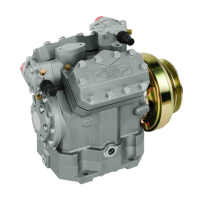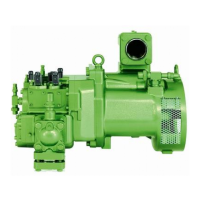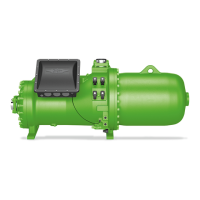19KB-570-1 RUS
ST-130-2
3
2.2 Maximale Ölniveau-Überwa-
chung
Elektrischer An schluss und Einbin -
dung in die Steue rungs logik sind von
der Konzeption der jeweiligen Anlage
abhängig.
So kann beispielsweise bei einer
Anlagenkonzeption mit überflutetem
Verdampfer ein Magnetventil in der
Ölleitung je nach Ölniveau im Verdich -
ter angesteuert werden. Ebenso ist
die Regelung einer Ölumspeisung im
Parallelver bund möglich.
2.3 Technische Daten
2.2 Monitoring of the maximum
level
The electrical connection and its inte-
gration into the control logic depend
on the design of the particular system.
Thus, for example, in an installation
with flooded evaporator, a solenoid
valve in the oil line can be activated,
depending on the oil level in the com-
pressor. Likewise, the oil circulation
can also be controlled in parallel.
2.3 Technical data
2.2 Contrôle du niveau d'huile maxi-
mal
Le raccordement électrique et l'incorpora-
tion à la logique de commande dépen-
dent de la conception de l'installation en
question.
Il est ainsi possible, par exemple dans le
cas d'une conception d'installation avec
évaporateur noyé, de commander une
vanne magnétique dans la conduite d'hui-
le, suivant le niveau d'huile dans le com-
presseur. La régulation d'un transfert
d'huile dans des compresseurs en
parallèle est également possible.
2.3 Données tech ni ques
Anschluss-Spannung Supply volt age Tension d'alimentation 230 V AC ± 10%
Netzfrequenz Supply frequency Fréquence du réseau 50 / 60 Hz
Verzögerungszeit (integriert) Delay time (integrated) Temporisation (integré) 5 s ± 2 s
Vorsicherung für Gerät Fusing for device and Fusible pour appareil et
und Schaltkontakte switch contacts contacts de commutation
Maximal zulässiger Druck Maximum allowable pressure Pression maximale admissible
Anschlusskabel Connecting cable Câble de raccordement
Kältemaschinenöle Refrigeration compressor oil Huiles pour machines frigorifiques alle / all / toutes
Kältemittel Refrigerants Fluides frigorigènes
Schutzart (montiert) Enclosure class (mounted) Classe de protection (monté) IP54
Zulässige Umgebungstemperatur Allowable ambient temperature Température ambiante admissible -30 .. +60°C
Gewicht Weight Poids 390 g
Opto-elektronische Einheit wird als
OLC-D1 ausgeliefert (siehe Seite 2,
Abbildung 1, Position 4)
andere Spannungen auf Anfrage,
auch mit UL-Abnahme erhältlich
Kabel sind farbkodiert
Opto-electronic unit is delivered as
OLC-D1 (see page 2, figure 1, pos. 4)
other voltages upon request, also
available with UL approval
Cables are color coded
Le composant opto-électronique est livrée
comme OLC-D1 (voir page 2, figure 1,
position 4)
d'autres types de tension sur demande,
aussi avec contrôle UL
Câbles avec code couleur
5 x AWG 20 (0,75 mm
2
)
L = 2 m
HFKW, (H)FCKW
HFC, (H)CFC
Relais-Ausgänge: Relay output: Sorties de relais:
Schaltspannung Switching voltage Tension de commutation max. 240 V AC
Schaltstrom Switching current Intensité de commutation max. 2,5 A
Schaltleistung Switching capacity Puissance de commutation max. 300 VA
max. 4 A
Maximale Öltemperatur Maximum oil temperature Température d'huile maximale 120°C
33 bar (-20°C .. -10°C)
45 bar (-10°C .. 120°C)
Geräte-Typ Device type Type de dispositif OLC-D1-S
Während der Einlaufzeit der neuen
Gleitring dichtung (ca. 250 Stunden)
kann eine erhöhte Leckölmenge aus-
treten.
Schädliche Einflüsse auf die Wellenab-
dichtung:
• zugeringeSauggas-Überhitzung,
insbesondere Nassbetrieb
• zuhoheRiemenspannung
• schlagendeRiemen
• thermischeÜberbelastung(Betrieb
außerhalb der Einsatzgrenzen)
• häugesTakten
• langeStillstandzeiten
• Material-Ablagerungen
• SchmutzausdemSystem
Durch diese Einflüsse kann die Wel-
lenabdichtung undicht werden und
muss getauscht werden. Ursache für
Undichtheit ermitteln und beseitigen!
Wellenabdichtungaustauschen
(Abb. 7)
Ausbau
• Befestigungsschrauben(5)des
Abschlussdeckels (4) herausdrehen.
• Abschlussdeckel(4)mitderHand
von der Welle (7) abziehen.
• DieGewindestifte(2)imGleitring(1)
lösen und entnehmen (nicht wieder
verwenden!). Anschließend den
Gleitring (1) von Hand von der Welle
(7) abziehen.
• Gegenring(3)derWellenabdichtung
aus dem Abschlussdeckel (4)
herausdrücken.
Achtung!
Radial-Wellendichtring (6) nicht
beschädigen!
Vorbereitung zum Einbau
• Abschlussdeckel(4)reinigen.
• BendensichAblagerungenauf
der Welle (7), müssen diese vorher
entfernt werden. Hierzu Putztücher
oder Ölgetränkte Polierleinen bzw.
Schleifleinen mit Körnung 280 oder
feiner verwenden.
During the running-in period of the
new shaft seal (about 250 hours) an
increased oil leak rate may occur.
Damaging influences on shaft seal:
• insufcientsuctiongassuperheat,
especially with wet operation
• excessivebelttension
• impactingbelts
• thermaloverload(operationoutside
of application limits)
• frequentoscillation
• longshut-offperiods
• materialdeposits
• Contaminationsfromthesystem
These influences can cause the shaft
seal to become leaky and require
replacement. Determine and eliminate
cause for leakiness!
Replacement of the shaft seal
(fig. 7)
Removal
• Screwoutthexingscrews(5)of
the sealing cover (4).
• Pulloffthesealingcover(4)from
the shaft (7) by hand.
• Loosenthesetscrews(2)insidethe
sealing ring (1) and remove (do not
reuse!). Finally pull the sealing ring
(1) from the shaft (7) manually.
• Pushoutthestationaryring(3)
of the shaft seal from the sealing
cover (4).
Attention!
Be careful not to damage the
gasket ring (6) on the sealing
cover!
Preparationfortting
• Cleanthesealingcover(4).
• Ifcoatingsareontheshaft(7),they
must be removed; for this purpose,
use cleaning rags and oil-soaked
emery cloths or emery cloths with
280-grit or finer.
Во время обкатки нового уплотнения
вала (около 250 часов) скорость утечки
масла может быть повышенной.
Воздействия, повреждающие сальник:
• недостаточный перегрев газа на
всасывании, особенно с «влажным»
ходом
• чрезмерное натяжение ремня
• биение ремней
• тепловая перегрузка (работа за
пределами области применения)
• частые колебания
• длительные периоды неиспользо-
вания
• частицы материала
• Загрязнения из системы
Эти факторы могут способствовать
появлению утечки и необходимости
замены сальника. Определить и
устранить причину неплотности!
Замена сальника
(рис. 7)
Демонтаж
• Открутите крепежные болты (5) из
защитной крышки (4).
• Снимите защитную крышку (4) с вала
(7) вручную.
• Ослабить установочные винты (2)
внутри уплотнительного кольца (1) и
удалить (не использовать повторно!).
И наконец, снять уплотнительное
кольцо (1) с вала (7) вручную.
• Выдавите неподвижное кольцо (3)
сальника из защитной крышки (4).
Внимание!
Будьте осторожны, не повредите
уплотнительное кольцо (6) на
защитной крышке!
Подготовка к монтажу
• Очистить защитную крышку (4).
• Если есть отложения на валу (7),
они должны быть удалены, для этого
используйте ветошь и пропитанную
маслом наждачную бумагу или
наждачную бумагу с зернистостью
равной 280 или меньше.

